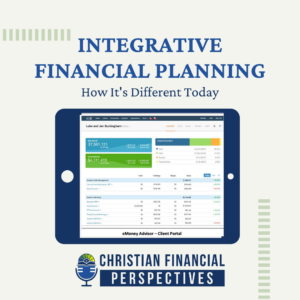Click below to listen to Episode 148 – Integrative Financial Planning – How It’s Different Today
Subscribe: Apple Podcasts | Google Podcasts | Spotify | Amazon Music | Stitcher | RSS | More
Integrative Financial Planning – How It’s Different Today
Integrative financial planning is a huge part of Christian Financial Advisors through primarily a tool called eMoney. We try to make your investment and financial planning as easy as possible through online tools that are easily accessible 24/7. So, what exactly makes eMoney so great? Bob and Shawn go step by step through an eMoney profile to break down exactly how the program is used and how Christian Financial Advisors uses this platform to create and show clients a financial plan.
Whether you are planning on saving college money for kids and grandkids, or you just need a place to start with creating retirement funds, integrative financial planning is a great place to start. We are here to help clear up any confusion or questions surrounding this process!
HOSTED BY: Bob Barber, CWS®, CKA®
CO-HOST: Shawn Peters
Mentioned In This Episode
Want to ask a question about your specific situation? Schedule a complimentary 15 minute phone call.
EPISODE TRANSCRIPT
Intro:
Welcome to Christian Financial Perspectives, where you’re invited to gain insight, wisdom, and knowledge about how Christians integrate their faith, life, and finances with a biblical worldview. Here’s your Christian Financial Advisor’s host, Bob Barber and his co-host, Shawn Peters.
Shawn:
Welcome to another episode of Christian Financial Perspectives. We’re so glad you joined us today. If you like content on financial topics from a Christian perspective, we encourage you to hit that subscribe button. As of recording, we still got about 80% of people watching that have not subscribed, but we’d like you to hit that subscribe button, if you don’t mind. It would help us out and it would also help other people who might be looking for this kind of content. Today we’ve got kind of a interesting format. We’re going to be looking at a bunch of stuff on the screen. Bob’s going to be kind of in the driver’s seat, if you will. Going over our client portal system called eMoney. So Bob, you want to give us a little introduction on that?
Bob:
Well, eMoney is our integrative financial planning program that we use. The reason I wanted to do this in the form of a podcast video, and by the way, podcast, you’re not going to get to see the screen, so I would really emphasize that you go to YouTube to see this. Shawn, every time I have an appointment with a client or even a pro prospective client, and when they see this program and how interactive this financial program is, this is interactive financial planning that is best. When they see this, I can just watch the nearly the scales drop from their eyes, and their fears go away because there’s so many unknowns in the financial planning arena and the future. What can we do? Can we retire on this? What about if we want to buy this new car, or we want to do this remodel?
What if we want to have this home on the coast, a second home or something like that? This system can do all that. I’m going to bring, for the next 15 minutes, I’m going to bring a little bit of this system to our audience so that you can see this and you can determine for yourself if you would like some financial planning. Some integrative financial planning. This is unlike the old days of financial planning. Where we used to take the information, we would go put it in a program, spit out a big thick financial plan, put it in a binder, give it to you, and that’s it. Until you redid it completely, that was the plan you went by. It’s not like that at all anymore, so I’m going to show our audience.
Shawn:
So really, I would summarize like this for those of you watching; e-Money, the way we use it here as as a firm allows us to make sense out of all of the craziness and cloudiness, when it comes to finances. Knowing how much you have in your investment accounts or your savings account, that’s really just one piece of the puzzle. There’s a lot more to it than that. This is what we use to help you figure out questions like, “Do I have enough for what I’m wanting to retire on for income?” “Are we on track to hit the numbers that we need to hit?” “Are we okay if we take the family on a cruise?” Maybe you’re going to take your kids and grandkids.
Bob:
On that big cruise or that Hawaii trip.
Shawn:
Exactly, so without further ado, Bob.
Bob:
Here we go. We’re going to pull up the screen here. This is called our eMoney system. It’s a system that a lot of financial advisors use. I’ve been using it for many years. I know it so good it’s from muscle memory. This is an actual client with the name changed, of course, the Frank and Joanna sample. What you’re seeing here on the screen is basically a snapshot of them. This is called our overview. We’re looking at their net worth. We’re looking at what they have in investments. We’re looking at their asset allocation overall. Then you’ll see, on the upper right hand corner, you’ll see their risk number and then what the risk is of the portfolio. That’s how much risk can they tolerate out of a scale from one to a hundred in their portfolio, which is a 68, and their portfolio is actually at a 64 right now.
Shawn:
So Bob, this is pulling in not just their assets under management with our firm, but it’s also bringing in any other held away assets. We’ve got 529 plans. There’s credit union, like money market, there’s, checking account. We’ve got Frank’s 401k from his work retirement account. We’ve got Joanna’s 403B. One of the things that’s that’s great about this is you can use it not just for what we’re managing for someone as a client, but you can also put in all of those other assets, so you can see your full financial picture. Then of course when you’re trying to make those financial planning decisions with an advisor you’re able to do that on the whole thing, not just the little piece of the pie, if you will, that we’re helpful.
Bob:
It’s a blueprint and you can’t build a home from a blueprint when you only have 10% of it, or 25% of it. Frank and Joanna, is that what I named them again? Frank and Joanna, I want to make sure because I changeg the name. A lot of that what’s in their moderate managed account, which is $746,000, a lot of that was inherited. About $400,000 that came from an inheritance a couple years ago. Then Joanna’s IRA rollover, she works for the hospital administration and that came over in the form of a 403 rollover. Then you can see down here Frank’s 401k where he is still working is at $522,000. This is so typical of many of the people I work with. Then they have $75,000 in CD’s, and then about $45,000 in their credit union, and then the kids.
So you see this, how does this look though? How does this look in real life? I’m going to go over to the five year cash flow and this is all the information that we enter into the five year cash flow. You’ll look at the top and the way the five year cash flow is, first it has the investments, and if you look where I’m on the screen and I highlight that in blue, you can see that that’s where the investments are expected to be at the end of 2023. This is their retirement accounts.
Shawn:
You’ve got investments, we’ve got retirement accounts, we’ve got cash accounts. We have if there’s any insurance accounts that have a cash value.
Bob:
You can see year by year that grows a little bit. One of the things with this particular couple is that while Frank makes a very good living over $200,000 a year with bonuses, and then Joanna has a part-time income making $38,000 These plan distributions are for education. If you go down right here, you’ll see this, the $31,703 and the 31,703 it’s coming out. That’s from a withdrawal coming from the 529 plans. Inside of here I’ve got Frank’s salary, his cash flow, living expenses, what’s expected, 529 withdrawals, and then their insurance premiums. What taxes he’s going to have to pay and they also want to buy a new car you can see in 2026. We’ve got that figured in here. You notice this, they’re negative cash flowing.
They went out, when they got that inheritance, they went out and bought a new home on the coast. I’m telling you it’s eating their lunch. Now, they’re okay because they have enough in their investments that the investments are overcoming that negative cash flow. But we’re having to pull that from the investments on a year by year. Now, I’ve got in the system here, their home, we’re going to be selling that beach home that they have in about 25 years. Otherwise, I’m going to show you this on a full cash flow, if you look at this, you see this blue line? This is their money going up and then they retire and this is their money coming down. If that blue line goes away, they’re out of money. Then they come in and they sell their beach home. You can see right here, when they look at cash flow, their beach home’s only valued at about $550,000 today. You can see 25 years down the road is expected to be with a, with a just a three and a half, 4% inflation rate.
Shawn:
Which is pretty reasonable.
Bob:
For about 1.2 and that money’s going to come back in because you can see that their investments were at 2 million. They got all the way down to $898,000. They sell their home, goes right back into it. That’s why when we go up here, we’ll see this move down and then we’ll pop that line back up. They’re still very much on the edge for their lifetime. Now I do have them all the way out to a hundred years old. There’s 98 and 97, it shows them running out of money. If you look right here on this line, when you look out to the far right, you’ll see that they run out of money at that point if they live that long.
Shawn:
Even those last couple years, they’re getting pretty low, pretty quick.
Bob:
Now we have our system, we can go in and ask it and we say, okay, what’s the maximum retirement spending they can do? Really, all they have to do is make a small adjustment here to their retirement spending in today’s dollars.
Shawn:
So that’s only a change of about $3,000 a year.
Bob:
That’s correct. It’s not much
Shawn:
Off of $120,000. Which is not much.
Bob:
Over time, what happens is the expenses, that is net of taxes, and also that compensates for inflation in the program.
Shawn:
Again, it’s a $3,000 change in today’s dollars, but over time, that starts adding a lot.
Bob:
$10,000 or 20,000 in tomorrow’s dollars. We have figured in here, we get back the cash flow and we’re over here for five year cash flow. This is one of the most important pages that someone can look at. You’ll see they have a son right now named Travis. I did change the name of the children too. They have a son named Travis who has two more years of college. He’s going to Texas A&M they’re actually, both their children are going to Texas A&M right now. That’s the cost to go to Texas A&M this year. They have two children in, and you can see that’s why a little bit of negative cash flow in there too. Then it drops off, if you go over here, you can see where Britney’s had her four years. Travis is finished up. You can see their age 59, and I can come up here and I can hit next five years. Next five years will give us where you are going to be. At that point, you’ll notice the kids completely drop off, but then right in here at age 65, you’ll see, it should be social security. See, social security’s starting to kick in right in here. Right off to the far right.
2032. I like to look at this and I like to say I’m going to pop it to where they’re about 65 years old. That’s going to pull up the range right here, and that’s going to show that social security completely kicking in and a few years for both of them. Which is quite a bit. Inside of that, we’ve got their living expenses, their taxes, everything’s in there. It even drops off. There’s your liabilities. That is the loan on their home, and the loan on their beach property. Eventually that drops off. If you pop this out to about 75 and you’re going to notice you won’t see that there anymore. iI will completely go away, and that’s all compensated for in the plan.
Let’s see if they still have some liabilities. Well, they do. They had a 30 year note, but it did go down some. What’s also neat about this is that I have built in here, like when they want to, they want to buy a new car in a couple years. They have a very old Lexus, they want to buy a new one. I have that compensated into the plan for them drawing that out in three or four years. There’s nothing we cannot put into the plan. This is how powerful this is. This is what I really wanted to show people. We got the balance sheet right here. This shows everything. This is updated every single day. As the markets change, as they pull money out, everything is updated.
Shawn:
When we’re looking at things like the five year cash flow, we’re looking at the, all these kinds of projections, there’s a lot of planning ahead where we’ve put in a client’s income, their, like you said, their inflows or cash flows. We put in all the different expenses. We put in the things that are planned may be five or six years from now, that’s whatever the case may be. Then what the system is doing is it’s taking all this information and looking at tax tables. It’s looking at in today’s dollars with assumed average inflation rates. There’s a lot of calculations going into this to make sure that everything is looking at, with it being adjusted. There’s rates of return on your investments, there’s the inflation on the actual expenses. All of it to basically help you answer those big questions of, “Do we have enough?” “Are we saving up enough for when we actually do retire?” What about all these things that come up? Really it all comes down to being open and transparent. If you let us know what it is that you’re planning for, we can put it in the numbers, and we can help you figure out options to meet those goals and needs.
Bob:
Once this is put into the system, all you have to do is tweak it.
Shawn:
So, your income changed a little bit.
Bob:
We can change that. We do it all the time. See right here where you see Frank’s earnings, at $267,000, that’s what it’s expected to be when he’s 63, 64, then he retires. It goes to zero. All that’s compensated for in here, Joanna’s earnings, she wants to retire at the same time that Frank wants to retire, so all that goes to zero at that point. The kids’ college is done with too. At any point they could say, well, we don’t want that beach home anymore. We’re going to go ahead and sell it now. We come back in, we readjust it. Instead of it getting so low before they do sell it.
Shawn:
Well the other part that I really like in eMoney is the decision center.
We can plug in and say, instead of changing the core facts, what we could do is go in and just say, well, what if in this case Frank decided to retire a couple years early? What if he retired a few years later than originally planned? We can quickly put in there and see, well, how much of a change is that going to make? In that chart we saw the money going down over time.
Bob:
Here’s the decision center, and this is where you can see, we can toggle these. There’s the home remodel because they want to do a remodel and I can toggle that switch off. I’m trying to toggle it. There you go. It will toggle that switch off, and you’ll watch, this should raise the number a little bit. Okay, there we go. It will raise or lower the number depending on how I toggle this switch. There’s where they want to buy a new car, and I can toggle that switch to on.
Shawn:
Give it a second.
Bob:
All right. Got it.
Shawn:
You have to give it a second.
Bob:
You can see where that will change the number as well. As we toggle these switches back and forth, we can go into. This is where we manage what we call techniques. Look at this. This is very powerful. We can add any other expense, additional expenses, gifts to charities, gifts to a person.
Shawn:
We can also do some positives, like adding additional income or selling some property. We’ve got changing growth rates or some assumptions on retirement ages. So there’s a lot, which we don’t want to go over this for an hour.
Bob:
We’re pretty much done. We are done for today and showing you how this works. What’s interesting about this too, Shawn. Is people have been amazed at how fast I am. I can do most of this information in just two or three hours, we can get this in. The financial plans nowadays are much cheaper than they used to be.
Shawn:
The added benefit, Bob, of after you’ve gone through this the first time, if someone is working with us as a client, they come back a year or two later, like you said, we’re not starting from scratch. We’re just, let’s confirm a few things. Has your income changed? Have any of your average living expenses changed? Were you going to sell anything? We make a few quick adjustments and now we’re ready to go. So what is it we’re trying to decide?
Bob:
Shawn, I love this thing. Some people are like, man, you are a nerd, Bob, you really love it, but I do. People watch me operate and it is, it’s nearly from muscle memory. I’ve been doing it for over 15 years and it’s just, I’m so fast in it. You can’t throw anything at me that I’m not going to be able to put that in and show you how that’s going to affect your plan.
Shawn:
Well, I’m glad you like it, Bob. I think you’re, I think you’re probably in the right career then.
Bob:
Well, I hope this has helped y’all a lot to see just how innovative and integrated financial planning is today. If you want some help, give us a call. We’d love to come alongside you as Christian Financial Advisors and help you. Our phone number is (830) 609-6986. You can call or text that number during business hours central standard time, or go to our website. A lot of good information on our website about how we do all this. There’s a financial planning page. It goes into all these areas as well. That’s christianfinancialadvisors.com. Anything you want to say before we end, Shawn?
Shawn:
Yeah, I was just going to say, if you’re watching this and you really like this type of a presentation where we kind of dive into something just more real world instead of kind of talking more theoretical. Not showing as much on screen, let us know in the comments. If there’s any other topics or categories similar to this that you’d love to have us cover. Let us know in the comments. Like Bob said, call or text us. Thank you God bless.
[CONCLUSION]
That’s all for now.
We invite you to listen to all of our past episodes covering many financial topics from a Christian Perspective. To make sure you don’t miss any of Bob’s upcoming episodes you can subscribe to Christian Financial Perspectives on iTunes, Google Play Music, Spotify, or Stitcher. To learn more about integrating your faith with your finances, visit ciswealth.com or call 830-609-6986.
[DISCLOSURES]
Investment advisory services offered through Christian Investment Advisors Inc dba Christian Financial Advisors, a registered investment advisor registered with the SEC. Registration as an investment advisor does not imply a certain level of skill or training. Comments from today’s show are for informational purposes only and not to be considered investment advice or recommendations to buy or sell any company that may have been mentioned or discussed. The opinions expressed are solely those of the hosts, Bob Barber and Shawn Peters, and their guests. Bob and Shawn do not provide tax advice and encourage you to seek guidance from a tax professional. While Christian Financial Advisors believes the information to be accurate and reliable, we do not claim or have responsibility for its completeness, accuracy, or reliability.












